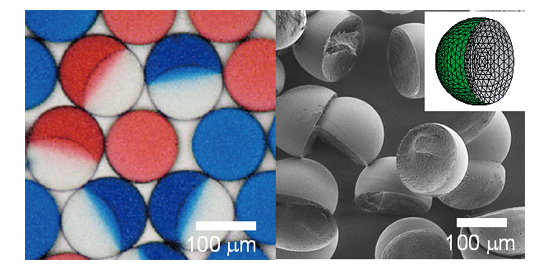Microparticles that appear different depending on the direction you look at them are said to have anisotropic shapes. Such particles have a diverse spectrum of applications, because when they are packed together the resulting materials exhibit unique bulk properties affecting the way they flow, coagulate and scatter light.
However, anisotropic microparticles are difficult to make. Conventional solution-based methods demand complicated material formulations, and thus do not provide much flexibility in terms of controlling the size and morphology of the particles.
Now, Takasi Nisisako and colleagues at Tokyo Institute of Technology have developed a microfluidic emulsion generator that can be used for producing polymeric particles with controlled sizes and shapes.
The equipment contains microfluidic channels that comprise a Y-junction and a T-junction. At the Y-junction, a two-phase organic stream of photocurable and non-curable phases is formed. Then, at the downstream T-junction, so-called Janus droplets comprised of two halves with different properties are generated with a cross-flowing aqueous stream. The droplets are then photopolymerized to form templated non-spherical particles.
The Janus droplets had narrow size distributions, for example the mean size was 119 micrometres with a coefficient of variation of just 1.9%. The researchers then initiated polymerization using UV light. This yielded monodisperse particles with controlled convex or concave structures, which could be tuned by varying the flow rate ratios between the two organic streams.
This technique could be enhanced to design particles with more complex shapes such as biconvex or biconcave lens-shaped particles, by increasing the number of organic streams.
Movie clip of the formation of Janus droplets in the double-T junction, recorded at 10000 fps.
Reference
- Authors: Takasi Nisisako and Takeshi Hatsuzawa.
- Title of original paper: A microfluidic cross-flowing emulsion generator for producing biphasic droplets and anisotropically shaped polymer particles.
- Journal, volume, pages and year: Microfluidics and Nanofluidics 9, 427–437 (2010).
- Digital Object Identifier (DOI): 10.1007/s10404-009-0559-6
- Affiliations: Precision and Intelligence Laboratory, Tokyo Institute of Technology
- Department website: http://www.pi.titech.ac.jp/index-e.html


Janus emulsion droplets (left) and polymerized nonspherical particles (right)
. Any information published on this site will be valid in relation to Science Tokyo.



